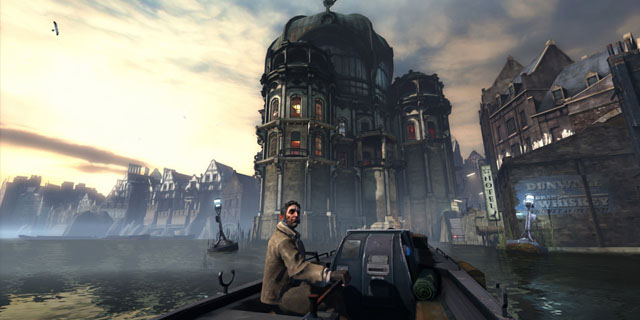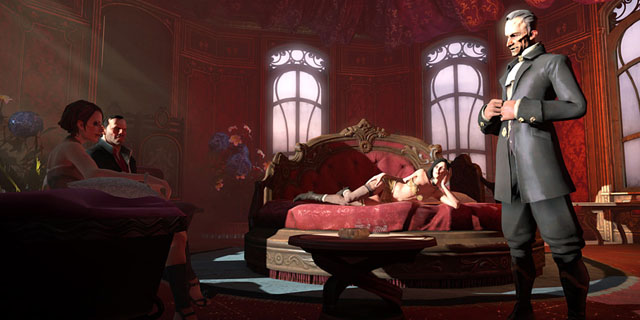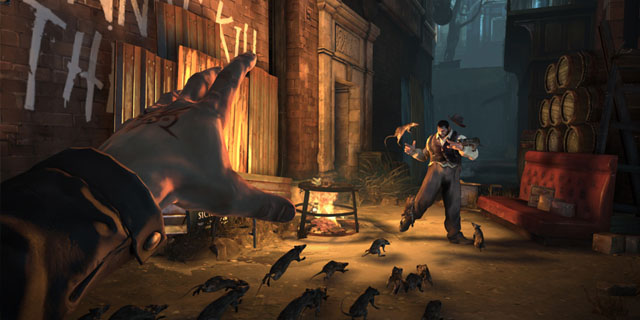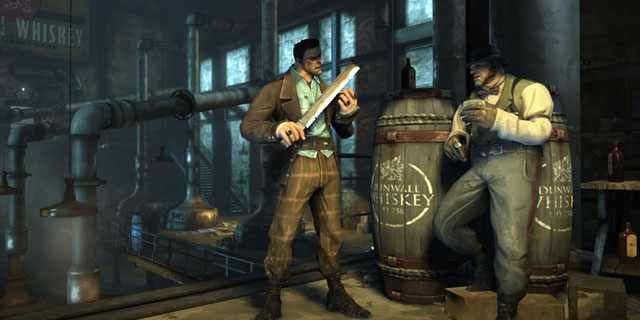
Every now and again, we come across certain games that offer players a large toolset, allowing them to progress through situations as they see fit. These games are few and far between, but allow those who wish to experiment and try new things to do so. Dishonored is the kind of game that is as much about the end goal as it is how you reach that goal, offering plenty of opportunities to go about it however the player chooses. As a result, it is an experience as rewarding as it is unpredictable.
In the port city of Dunwall, our hero, Corvo, is bodyguard of the Empress and protector of the eventually successor to the throne, Emily. It isn’t long before the Empress is murdered by assassins, Emily is kidnapped and Corvo is blamed for these crimes and sentenced to be executed. Eventually he escapes, meets up with a group of allies and vows revenge on the men who have betrayed him and now attempt to control the empire. The setup is fine, but as the plot gets moving and certain things fall into place you’re left with a strong story, complete with many twists and turns along the way. It’s not a complex story, but one that has many small moments of brilliance weaved in throughout its narrative.

Once you get past the prologue and escape from the prison, learning the ropes of the controls and the methods in which you can approach enemy encounters, you will delve into the real meat of the game. Corvo will use both hands at all times, his right always holding his trusty blade, and his left either holding a weapon (pistol, crossbow or grenades) or equipped to use one of his many powers, which he gains access to after the prologue. These powers and how you choose you use them, as well as how you approach each mission, make up the core of Dishonored. Some abilities reward stealth, while others are purely offensive, allowing you to mix and match as you see fit and rewarding experimentation above all else.
The main ability you gain right from the start is Blink, which allows you to teleport from one location to another. This power will take some getting used to and it can be rather finicky, but once you get a handle on it, you’ll be moving from place to place with ease. This is what separates Dishonored from other games of this ilk. Movement feels fluid and dynamic, and once you master the Blink ability, you’ll find yourself able to climb anywhere the game allows you to as well as escape from dangerous encounters without so much as a scratch.
Not only that, but the actual climbing mechanics work wonders; if you see an object you can climb up, you simply press the A button, allowing you to maneuver over the obstacles quickly. The Blink ability is one of the coolest mechanics introduced in a game like this, and it removes any and all tedium from the act of traveling around in this world. Simply put, I can’t image playing a game like this without having a similar ability.

As you collect objects in each area called runes, you can use them to unlock and upgrade other abilities, such as Dark Vision, allowing you to see enemy movements and their cone of vision through walls, and Possession, which you can use to take control of rats, fish, or even people. These abilities all have their particular uses and, depending on your play style, can be combined in order to sneak past enemies, take care of them quietly or fight them head on. For example, you can use the Bend Time power in conjunction with Windblast, an offensive ability, to slow down time and knock your enemies to the ground, giving you a chance to escape or finish them off with your weapons. The combinations seem limitless, and there will always be several different ways to progress through each situation and encounter.
Thanks to your many abilities and weapons, you can advance through the game in two central fashions: lethally or non-lethally, the latter mostly involving stealth. Stealth is a key component of this game and, even if you are not terribly good at stealth games, you will find yourself able to get a grasp on the mechanics easily enough to adjust to this approach. Stealth works great and allows for a lot of experimentation, thanks to some of the tools at your disposal. For example, you silent crossbow can be equipped with sleep darts for a non-lethal way to take care of enemies from afar.
You will always be able to take out enemies without killing them if you choose to tackle encounters that way, but there are other options at your disposal as well. You could possess a rat and crawl through a small tunnel to carefully avoid an area, or slow down time and use the Blink ability to travel through an area full of enemies without them even being aware you were there. Avoiding combat (or relying on it as sparingly as possible) can be very rewarding.

If you do choose to engage in combat, you’re in luck: it’s very satisfying and, as you may expect, also allows for plenty of improvisation. Your sword, the main weapon at your disposal, can be used to block and quickly counter enemy attacks, which is easy to pull off and very handy when in a one-on-one fight. When faced with several enemies, you have your pistol, which can decimate a good number of them in a relatively short amount of time, although it does make a lot of noise. The combat is a blast, and although I never found myself focusing on it too much during my particular playthrough, the moments when I did choose to fight I enjoyed immensely.
How you approach the game, either lethally or non-lethally, will affect the world around you as the game progresses and also works its way into the story. Dunwall suffers from a plague that has been caused by an infestation of rats, and it turns ordinary, infected humans into creatures known as Weepers. If you choose to kill many people throughout your journey, the world will begin to become more populated by Weepers as well as groups of flesh-eating rats. However, if you show restraint and tackle combat non-lethally or avoid it altogether, these problems will not persist. It’s a brilliant design choice that balances the difficulty no matter what choices you make. Stealth may be the more difficult, time-consuming method, but you will be rewarding by not having to deal with other obstacles later on in the game. And, by the time your mission of revenge is ultimately complete, the game’s ending will change based on these events as well.
On top of the excellent gameplay and rewarding mechanics at work, Dishonored looks and sounds stunning. The visuals, which blend together stylistic and gorgeous environments with cartoonish, odd, but otherwise marvelous character designs, are great. The sound design is something to admire as well. You know just when you have been noticed, you will always know how much sound you are making as you move through environments, and if you are careful, you’ll be able to hear the conversations of your enemies as you watch them from the shadows. There is a lot to love about the presentation, and it only adds to the game’s enthralling nature.
No matter your interest in games of this style, Dishonored is a must-play title. Although it’s not the longest game in the world, you will feel compelled to play through missions or the entire game multiple times to discover the diverse number of ways to take on different sections. Thanks to the incredible toolset at your disposal and its ingenious mechanics, you will quickly fall in love with this expertly-crafted and finely-tuned experience.
Pros: Brilliant presentation, strong story, plethora of abilities that allow for experimentation
Cons: Blink ability can be finicky at times



















